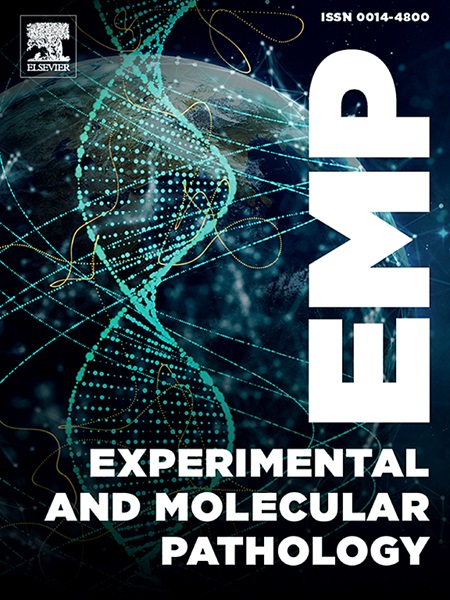丁酸梭菌与抗生素同时使用单一混悬液对艰难梭菌感染小鼠的影响
IF 3.7
4区 医学
Q2 PATHOLOGY
引用次数: 0
摘要
一种简单的悬浮法,其中片剂和胶囊在温水(55°C)中崩解,越来越多地用于临床环境。先前,我们证明了益生菌制剂与甲硝唑或非达霉素同时简单混悬时益生菌菌株的检出限降低或低于检出限。本研究探讨其对艰难梭菌感染(CDI)小鼠的治疗效果。方法本研究使用的丁酸clostridium产品及抗生素为Miya-BM片(CBM)、甲硝唑片(Flagyl 250 mg口服片)、非达霉素片(dafclr 200 mg片)。未感染的小鼠同时接受CBM和抗生素的简单悬浮液,以评估粪便中益生菌的活力。此外,用这些悬浮液处理cdi感染小鼠,观察了艰难梭菌计数和细胞因子的产生。在同时注射CBM和抗生素悬浮液的未感染小鼠的粪便中检测到丁酸。在cdi感染小鼠中,与CBM或单独使用抗生素相比,同时悬液可显著降低粪便中艰难梭菌菌落计数。此外,悬浮液下调肿瘤坏死因子-α (TNF-α)、白细胞介素-6 (IL-6)和IL-10水平,同时上调结肠组织中的干扰素-γ (IFN-γ)水平,表明炎症减少和免疫反应增强。结论本研究证实了中药与抗生素同时单混悬液治疗CDI的有效性。这种方法可以显著减少艰难梭菌计数,调节细胞因子水平,并保持益生菌活力,可能使其成为临床环境中通过胃管给药的可行选择。本文章由计算机程序翻译,如有差异,请以英文原文为准。

Effect of Clostridium butyricum and antibiotics using simultaneous simple suspension in mice with Clostridioides difficile infection
Background
A simple suspension method, wherein tablets and capsules are disintegrated in warm water (55 °C), is increasingly used in clinical settings. Previously, we demonstrated that probiotic strains were reduced or below limit of detection in a simultaneous simple suspension of probiotic preparations and metronidazole or fidaxomicin. This study investigated its effectiveness in mice with C. difficile infection (CDI).
Methods
Clostridium butyricum products and antibiotics used in this study were the Miya-BM tablet (CBM), metronidazole (Flagyl 250-mg oral tablet), and fidaxomicin (Dafclir 200-mg tablet). Non-infected mice received a simple suspension of CBM and antibiotics simultaneously to assess probiotic viability in the feces. Additionally, C. difficile counts and cytokine production were investigated in CDI-infected mice treated with these suspensions.
Results
C. butyricum was detectable in the feces of non-infected mice receiving simultaneous suspensions of CBM and antibiotics. In CDI-infected mice, simultaneous suspensions significantly reduced C. difficile colony counts in feces compared to CBM or antibiotics alone. Furthermore, suspensions downregulated tumor necrosis factor-α (TNF-α), interleukin-6 (IL-6), and IL-10 levels, while upregulating interferon-γ (IFN-γ) levels in colon tissues, indicating reduced inflammation and an enhanced immune response.
Conclusions
This study using mice demonstrates the effectiveness of simultaneous simple suspensions of CBM and antibiotics in treating CDI. This approach significantly reduces C. difficile counts, modulates cytokine levels, and maintains probiotic viability, potentially making it a viable option for administration via gastric tubes in clinical settings.
求助全文
通过发布文献求助,成功后即可免费获取论文全文。
去求助
来源期刊
CiteScore
8.90
自引率
0.00%
发文量
78
审稿时长
11.5 weeks
期刊介绍:
Under new editorial leadership, Experimental and Molecular Pathology presents original articles on disease processes in relation to structural and biochemical alterations in mammalian tissues and fluids and on the application of newer techniques of molecular biology to problems of pathology in humans and other animals. The journal also publishes selected interpretive synthesis reviews by bench level investigators working at the "cutting edge" of contemporary research in pathology. In addition, special thematic issues present original research reports that unravel some of Nature''s most jealously guarded secrets on the pathologic basis of disease.
Research Areas include: Stem cells; Neoangiogenesis; Molecular diagnostics; Polymerase chain reaction; In situ hybridization; DNA sequencing; Cell receptors; Carcinogenesis; Pathobiology of neoplasia; Complex infectious diseases; Transplantation; Cytokines; Flow cytomeric analysis; Inflammation; Cellular injury; Immunology and hypersensitivity; Athersclerosis.

 求助内容:
求助内容: 应助结果提醒方式:
应助结果提醒方式:


